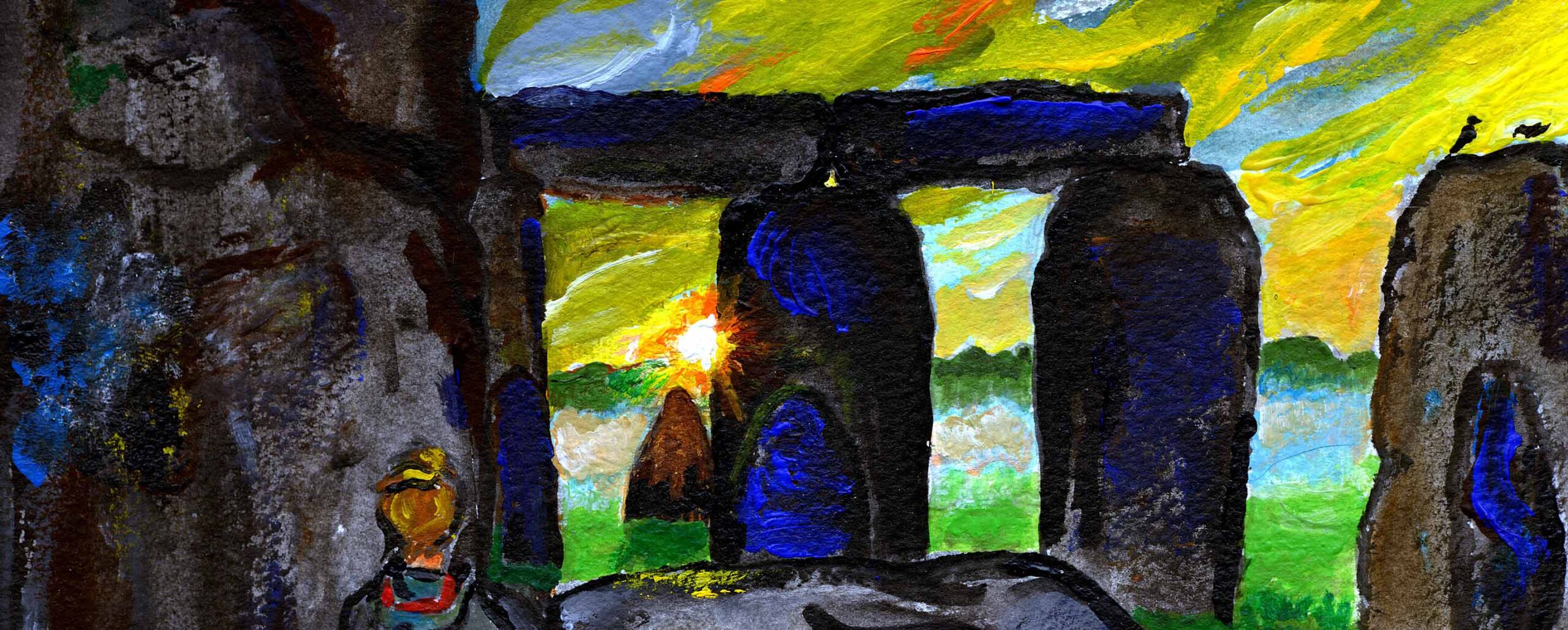Comet C/2013 US10 Catalina will be at perihelion tomorrow, Nov. 15. —Please see note at end.
This is, as yet, something to be seen in the mind’s eye. The comet is only 14 degrees west of the Sun, so only a degree above the horizon at the time and place of our scene.
In this three-dimensional picture, adapted from one in Astronomical Calendar 2015,
– the tick represents the perihelion, the nearest point to the Sun, where the comet will be tomorrow. You can see that this point is inside Earth’s orbit, only 0.8 of an AU (astronomical unit, Sun-Earth distance) from the Sun. You can see why the tail, driven outward from the Sun, appears to us foreshortened; and you can see that the comet is passing through perihelion shortly before climbing northward through the ecliptic plane (ascending node Nov. 26).
It has only just emerged from behind the Sun (conjunction, 8 degree south of the Sun, was on Nov. 4), so we have to see it 1.745 AU away and only just to the Sun’s “right” (west). Its magnitude could be about 6 (the approximate naked-eye limit) or even 5, but that’s of little use to us yet.
In the coming days, not only will the comet be higher to the north and more conveniently out into the morning sky – north from the ecliptic and also (from Dec. 17) north of the celestial equator – but we will be proceeding along our orbit as if to meet it. So we will get nearer to it (less than 1 AU from Dec. 16 on), and though now distancing itself from the Sun it should appear brighter, by perhaps half a magnitude in the middle of January.
There is more about this comet in its quarter-page of Astronomical Calendar 2015 – more than a quarter of a page, because its ladder-like journey almost to the sky’s north pole necessitated an awkwardly tall special chart! It is a “dynamically new” comet, meaning that it was one of the slowly orbiting clumps of matter in the remotenesses of the Oort Cloud; gently nudged by the gravity of other stars, it has dived for the first time to within our little sphere of observation. As it did so the ellipse of its orbit shortened to fewer millions of years. But as it came among the gravitational pulls of the planets, the orbit has been slightly deflected again so that, as it now bends around the Sun, its speed will reach (by my rough calculation) 46.4 kilometers per second. And this is, at this ditance, more than the escape velocity from the Sun; in other words, the comet’s orbit becomes open – a hyperbola – and it is doomed to leave the solar system for the space among the stars.
–I had prepared this post (expecting it to take a quarter of an hour and, as typical, still adjusting it hours later) when I heard of the atrocities in Paris and Beirut. To go silent out of respect, as others are choosing, or to carry on, as others are? I don’t know which is right. I know I don’t want to be like those who so savagely know they are right that they can do things like this.



Thanks Guy. I am looking forward to observing this comet!
Rather than saying C/2013 US10 is “doomed” to leave the solar system, one could just as easily believe that it’s hyperbolic path is a rare opportunity to journey into interstellar space. Given that there is a waiting list for one-way tickets to Mars, I’m sure we could find at least a few people willing to hitch a ride on this comet “to boldly go where no one has gone before.”
And I believe that in response to terrorism it is best to continue doing what one can to make the world a better place, as you do with this blog.
Yes. Flying out centrifugally has its appeal. As a child I wanted to fly out centrifugally from home. On learning that Arcturus appears relatively fast-moving because it is punching through the plane of the galaxy and will go on far out into the halo, I had the thought that it would be nice to hitch a ride with it and (in a few million years) see our galaxy as we can never see it. But on second thoughts I’d rather stay at home among our neighbors in the galactic plane.
I haven’t read more than a few dozen pages, so I can’t give it an actual recommendation, but on the strength of her past efforts, you definitely should give “Dark Matter and the Dinosaurs,” by Lisa Randall a look-see.
Well said Guy!
Love,
Terry